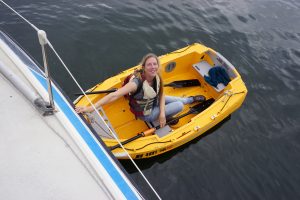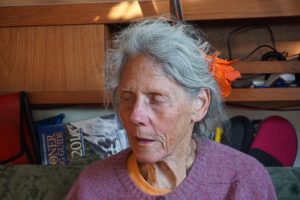17-MAY-2017, Johnstone Strait – Yesterday morning we had two conflicting weather reports. Environment Canada said wind on the nose up Straits of Georgia and in to Johnstone Strait.
Our GRIB files said four knots the entire day.
The Strait outside Campbell river was flat and calm. As we made our decision to leave all 100 feet of Discovery, who was docked across the finger dock from us, powered up.
The night had been a real windstorm with moments of driving rain. When on an anchor, the boat general points into the wind. The portion of the cockpit in the dodger’s wind shadow stays dry.
At a dock, the boat is fixed. The wind storm blew straight into our cockpit dropping some water through the cockpit door – a wet mat’s worth. But the wind was also enough to blow our drop board windows into the cockpit. Currently, the top-two drop boards are held in place by gravity – when finished they will have toggles to hold them in place.
The backwash of the wind blowing into the cabin blew the two top boards our, fracturing each at one corner: Cosmetically annoying, but nothing more.
Unlike last year, this is a trip of everything working except those things that we knew needed work before we left. The only annoyance, as I have written, is the 135% Genoa that won’t fit in the bow locker.
When we left Campbell river the airs were zero to light. We motored against the current intending to arrive at Seymour Narrows at slack. Along the way we altered course to give two feeding humpback whales some space. We arrived at Seymour Narrows about 15 minutes late, but since the current was changing in our favor, there was no worry, although the standing waves had already started to begin.
However, the wind north of Seymor Narrows was ten or knots on the nose against the current, so it was rough. After a couple of hours we decided to call it a day and heading into ‘‘small inlet’’ — that is its name.
We were alone for an hour so and then Harmony, who we’ve been watching on AIS joined us across the inlet… far enough away that it was difficult to see when someone was on the deck to drop the anchor.
There was a surprising amount of wind coming into the inlet, though the water stayed flat. The holding was excellent on a mixture of sand and clay.
We launched the dinghy using the wire jib halyard and went for a row. This was the first time we took Hilary in the dinghy. She is less confident in getting into the dinghy, but no less competent.

The Pudgy is very stable. Hilary stood on the gunwale without the dinghy lurching. The dinghy rows well, but fits the three of us snugly. Four would be a push unless each took an oar and I’m not sure how that would work. Small Inlet is less than a km walk over to the Octopus Islands. Alone, Jennifer and I might have taken the walk, which our friend Scott Wilson has recommended.

The wind continued to blow through the night, but stopped sometime after midnight. By 5.30 am, Harmony was gone. Hilary slept while Jennifer and I prepped and made way. Breakfast was a cup of tea for Jennifer, water for me, and a scrambled egg in a corn tortilla for each of us. The last two days we have been eating meat and two much of it. We won’t fit into our foulies at this rate and we have each planned to return slimmer than we left.
The water maker is wonderful. We run it whenever we are under power, and on a sunny day, it used much less power than we create. We have yet to tap either of the water bladders in the main cabin setees. We are currently caching fresh water into a Coleman five gallon (US) water carrier, which may have been a mistake. The water from the water maker has no plastic taste, but the water in the stainless steel tank tastes decidedly plastic. We suspect it is the Coleman water carrier.
We have changed our connections at docks. We no longer connect to power. The solar panels supply all we need, and we have had no need of water – Though that is always supplied free, when it is available.
The dinghy on the deck is the biggest change. We ride much smoother and faster.
The engine still needs to be bled each morning, though this morning, there was no air in the line. I’ll continue to keep and eye in this.
All electronics and navigation are working well and we’re sailing as much as expected – much less than we’d like.

Hilary is rarely in reality unless we call to her, these days. She’s lost the ability to make yarn balls out of the lines on the boat, though she can still untie the stopper knots.
The main sail halyard winch looks like it will need to be replaced. I can do so with the Reefing winch I have with me and then get another used winch as we travel. The main sail halyard winch is bending alarmingly upward and was straightened too easily. This is most likely metal fatigue.
The combination of new sails, a hard slick bottom and not towing a dinghy has made a remarkable difference in the boat.
The stove is running on pure stove-grade kerosene and runs well once lit. Using a propane torch is such a nuisance that we leave the stove lit for long periods rather than go through the hassle of starting it. Wiping down the headliner to remove soot is now part of the standard dishwashing procedure.
Johnstone Strait, which we are motoring through as I write, is an unpredictable place. Today it is very placid. It can be a place of nightmares, though last fall on our way home we beat to windward through the strait with get speed, while towing an 11-foot dinghy.
Jennifer wants to make a long distance today and with the sub-five knot breeze we would not. So we (reluctantly on my part) motor.
[If you have just found our blog, leave us a comment, telling us how you found us and your thoughts.]

